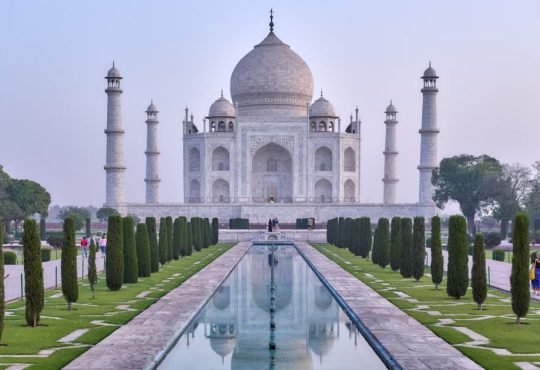Vietnam is a country that effortlessly blends ancient traditions, natural beauty, and modern vibrancy. From bustling cities to tranquil villages, towering limestone cliffs to serene beaches, Vietnam offers an array of experiences for every type of traveler. Whether you’re a history buff, a foodie, an adventurer, or just someone seeking a peaceful retreat, Vietnam should undoubtedly be on your travel bucket list. For those gearing up to explore this Southeast Asian treasure, this guide unveils the best destinations in Vietnam and essential tips to ensure your adventure is nothing short of extraordinary.
Top 8 Best Destinations in Vietnam
1. Ha Long Bay
Every trip to Vietnam is complete with experiencing the breathtaking beauty of Ha Long Bay, a UNESCO World Heritage Site. Travelers celebrate this legendary haven for its jade-hued waters, where countless limestone peaks soaring majestically from the sea.
The bay’s surreal and tranquil atmosphere makes it a paradise for photographers, nature lovers, and anyone seeking a serene escape. To explore the area, you can opt for various cruises, ranging from luxurious overnight trips to more budget-friendly day tours. These excursions often include kayaking, cooking classes, and visiting floating fishing villages, providing a perfect mix of relaxation and cultural immersion. Adventure seekers can explore the bay’s famous caves, such as Thien Cung and Sung Sot, which captivate visitors with their intricate stalactite and stalagmite formations.
2. Phong Nha-Ke Bang National Park
Phong Nha-Ke Bang National Park is an adventurer’s paradise, home to unparalleled natural marvels like Son Doong Cave, the most extensive cave system on the planet ever discovered. This UNESCO World Heritage Site features stunning caves, lush jungles, and a variety of unique ecosystems. Guided tours take visitors through remarkable caves such as Paradise Cave and Phong Nha Cave. Their jaw-dropping formations captivated and earned widespread acclaim. Beyond caving, the park offers plenty of outdoor activities like trekking, kayaking, and zip-lining, making it a haven for nature lovers. Hidden waterfalls add a refreshing touch to the experience, offering visitors the perfect opportunity to unwind after a day of exploration.
3. Ho Chi Minh City
Vietnam’s largest city, Ho Chi Minh City, also known by its historic name Saigon, is a dynamic mix of old and new. Here, ancient pagodas and colonial-era buildings coexist with modern skyscrapers, reflecting the city’s rich history and rapid modernization. History enthusiasts will appreciate visits to the War Remnants Museum, the Reunification Palace, and the iconic Notre Dame Cathedral Basilica of Saigon. At the same time, culinary enthusiasts can dive into the city’s lively food culture, savoring classics such as banh mi, pho, and bun thit nuong. The bustling night markets are also perfect for savoring local delicacies while soaking up the city’s energetic ambiance.
4. Hoi An Ancient Town
Hoi An, a UNESCO World Heritage Site, is a living relic of history, where lantern-lit streets and well-preserved architecture whisk visitors into a bygone era. This charming town blends history, culture, and relaxation, offering an enchanting experience. Visitors can explore a vibrant tailoring scene, where skilled artisans craft custom-made clothing at affordable prices—a perfect and unique souvenir. Beaches like Cua Dai and An Bang provide a tranquil escape, while the town boasts a wealth of cultural landmarks, including temples, pagodas, and the iconic Japanese Covered Bridge. With its captivating charm, Hoi An offers travelers a serene escape, making it an essential stop for those craving a more relaxed rhythm of life.
5. Sapa
Nestled high in the northern mountains, Sapa is a haven for trekkers and those eager to immerse themselves in Vietnam’s rich cultural diversity. The region is known for its stunning rice terraces, mist-shrouded peaks, and vibrant hill tribe villages. Trekking through Sapa’s lush valleys and terraced fields is a highlight, offering breathtaking views at every turn. Beyond the landscapes, Sapa offers cultural immersion with visits to villages inhabited by ethnic groups such as the Hmong, Dao, and Tay. The colorful local markets provide a lively setting to experience traditional crafts, foods, and daily life, making Sapa a unique and unforgettable destination.
6. Mekong Delta
The Mekong Delta, Vietnam’s “rice bowl,” is a tranquil and scenic region characterized by its winding waterways and thriving agricultural landscapes. This area provides a quiet getaway from city life, highlighting rural Vietnam’s natural beauty and cultural traditions. Visitors can explore bustling floating markets like Cai Rang and Cai Be, where vendors sell everything from fresh produce to local delicacies directly from their boats. Beyond the markets, tours of fruit orchards and traditional workshops provide insights into local life. Don’t miss the chance to enjoy the region’s fresh seafood and tropical fruits, such as dragon fruit and rambutan, for an authentic taste of the Delta.
7. Da Nang
Da Nang, a laid-back coastal city, is an ideal destination for beach lovers and culture enthusiasts. My Khe Beach, often ranked among the best in Asia, offers pristine sands and crystal-clear waters, making it ideal for relaxation. For a touch of adventure and history, visitors can explore the Marble Mountains, a cluster of limestone hills with caves, pagodas, and breathtaking panoramic views. Nearby, the My Son Sanctuary—an ancient Cham civilization site—offers a glimpse into Vietnam’s fascinating history, with its well-preserved ruins dating back to the 4th century. Da Nang is a versatile destination that caters to both relaxation and exploration.
8. Nha Trang
Nha Trang is Vietnam’s ultimate beach destination, boasting crystal-clear waters, vibrant coral reefs, and a lively nightlife. This coastal city offers an array of aquatic adventures, including snorkeling and diving at Hon Mun Island, where marine life thrives in its colorful underwater world. Visitors can choose from luxury resorts or budget-friendly accommodations, ensuring a comfortable stay for all budgets. Beyond the beaches, cultural landmarks such as the Po Nagar Cham Towers provide a fascinating glimpse into the region’s ancient history and stunning city and coastline views. Whether you want to unwind or explore, Nha Trang promises an idyllic coastal getaway.
Practical Tips for Your Trip
1. Best Time to Visit
Vietnam’s climate varies significantly depending on the region, so the best time to visit depends on where you’re going. From November to April, the dry season is generally the ideal time to explore most destinations nationwide. In the north, the most pleasant weather can be found during spring (March to April) and autumn (September to November), when temperatures are mild and rainfall is minimal. During these times of the year, the conditions strike an ideal harmony for exploring attractions and enjoying outdoor adventures. The dry season is also the best time for the central and southern regions, avoiding the heavy rains typical of the summer months.
2. Visa Requirements
Vietnam has made the visa application process more accessible with an e-visa system available for travelers from many countries. This system enables visitors to apply online, eliminating the need to visit an embassy or consulate. Reviewing the visa regulations specific to your nationality is essential to confirm your eligibility for an e-visa or determine if another visa type is needed. Complete your visa application well in advance to avoid any last-minute issues. As visa policies can change, always verify the latest requirements before planning your trip.
3. Currency
The official currency in Vietnam is the Vietnamese Dong (VND), though U.S. dollars are commonly accepted in major tourist areas. While many larger businesses and hotels may accept U.S. dollars, smaller shops, restaurants, and markets typically only accept Vietnamese Dong. Getting acquainted with the latest exchange rates and keeping a small amount of local currency on hand for daily expenses is a smart move. ATMs are readily available in cities, but travelers should carry cash, especially in remote areas where businesses often refuse card payments. Using local currency will help you avoid unfavorable exchange rates and fees.
4. Transportation
Getting around Vietnam is convenient and affordable, with multiple options to suit different travel styles. Flying domestically offers the fastest way to traverse vast distances, allowing seamless travel between key cities such as Hanoi, Da Nang, and Ho Chi Minh City. For a more scenic journey, the Reunification Express train offers breathtaking views, particularly along Vietnam’s coastal routes. Buses are a budget-friendly choice and are widely available in every city, connecting urban centers to rural areas. For shorter trips or a more adventurous experience, renting a motorbike is a popular option, especially for exploring countryside roads and hidden gems. No matter your choice, Vietnam’s transportation network ensures a smooth and enjoyable travel experience.
5. Accommodation
Vietnam offers a wide range of accommodations, catering to every budget and travel preference. Backpackers can find affordable and social stays in hostels, which are plentiful in popular tourist areas. Mid-range and luxury hotels are available in cities and beach destinations for those seeking more comfort. Travelers looking for an immersive experience should consider staying in a homestay, particularly in rural regions like Sapa and the Mekong Delta, where hosts provide insight into local traditions and daily life. With options ranging from budget-friendly to opulent, Vietnam ensures that every traveler can find a place that feels like home.
6. Food
Vietnamese cuisine is a culinary adventure and a highlight of any visit to the country. Start with a bowl of pho, the iconic noodle soup that locals and visitors love. Try banh mi, a baguette sandwich with flavorful ingredients like pickled vegetables, meats, and herbs for a quick bite. Spring rolls, whether fresh or fried, are another must-try, offering a perfect balance of textures and flavors. Beyond these staples, Vietnam’s street food scene is rich and varied, so take the opportunity to explore local dishes in bustling markets or humble food stalls. The vibrant flavors and freshness of Vietnamese cuisine will leave a lasting impression.
7. Safety
Vietnam is generally a safe destination, but taking basic precautions can ensure a worry-free trip. To avoid petty theft, keep your valuables secure, especially in crowded areas. Regarding health, stick to bottled water and opt for freshly prepared food to minimize the risk of illness. Traffic in busy cities like Hanoi and Ho Chi Minh City can be overwhelming, so exercise caution when crossing streets, as motorbikes and vehicles often move in unpredictable patterns. By staying mindful and prepared, you can focus on enjoying Vietnam’s incredible sights and experiences.
Why Vietnam Should Be Your Next Travel Destination
Vietnam is a country of captivating contrasts, where ancient traditions blend seamlessly with modern innovation. Whether it’s the breathtaking views of Ha Long Bay or the picturesque hikes through Sapa’s mountains, adventure awaits at every turn. The vibrant street markets offer a chance to savor iconic dishes like pho, adding to the richness of the experience. With its diverse culture, history, and natural beauty, Vietnam is a destination that promises something for every traveler. Prepare to embark on an unforgettable adventure through this remarkable country—pack your bags and go!





